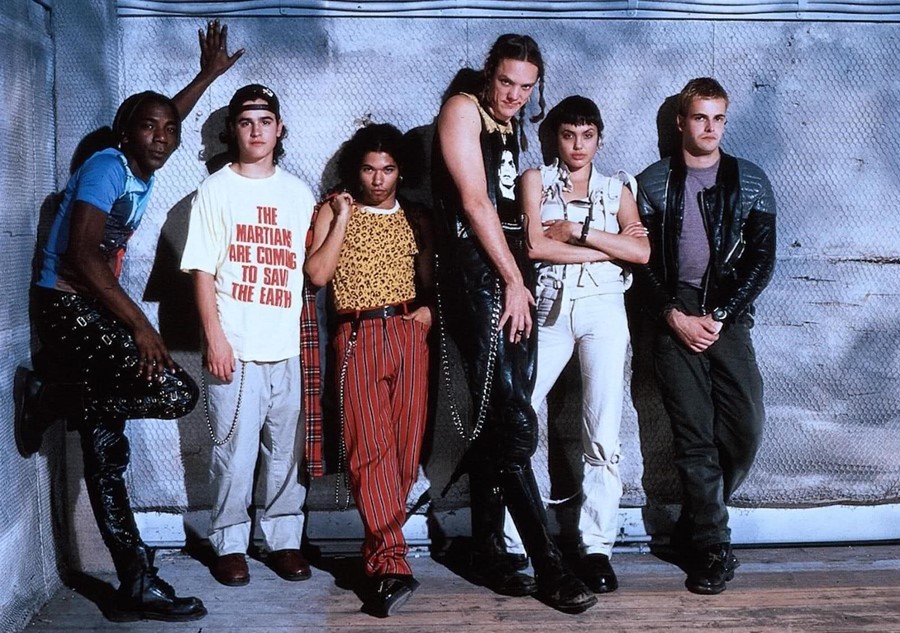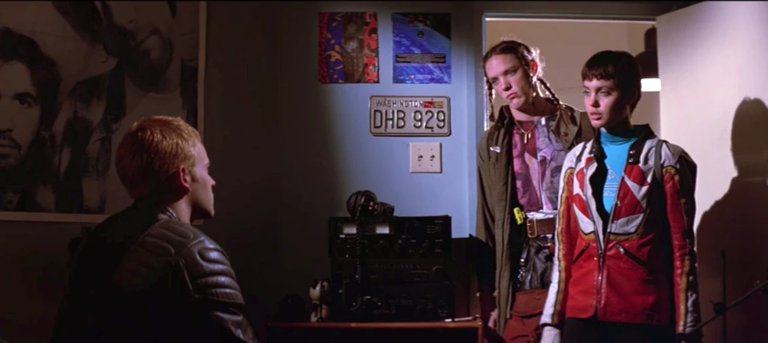God gave men brains
Larger than dogs so they
Wouldn’t hump women’s
Legs at cocktail parties.
(Ruth Libby)
Written by Rafael Moreu, following his fascination with computer hacking in 1980s and the hacker culture in general, the 1995 (computer) crime thriller Hackers, while unsuccessful at the box office at the time and not lauded by critics, went on to achieve a cult classic status, being reflective of the youth of entire decade in ways no other movie managed to cover that time period. The words “we are each our own country” by the movie’s antagonist, computer security officer Eugene "The Plague" Belford (played by Fisher Stevens from Short Circuit movies) is what sums up most of Hackers' characters of, give or take, high school age. The film is a celebration of individualism with different haircuts, hair colours and clothing.

The main cast of Hackers movie. Source
Hackers costume designer was Roger K. Burton, who’s known for dressing literally hundreds of influential musicians, from David Bowie to the Rolling Stones to The Cure, and the reason I want to especially mention him here is how he’s described his inspirations for dressing Hackers characters to Vice website: “I was really inspired by the way New York street punks looked, in filthy, ripped, and torn garments but with elements of punk, like tartan and zips and chains and colored hair, that were worn with such attitude, and also the cross-dressing club kids and fetish scene I saw around the meatpacking district.” Burton also credits the “outrageously dressed but incredibly chic” staff at Patricia Field’s House of Field, and the hi-tech cartoon surreal outfits he witnessed at the drag festival Wigstock. “All these combined looks became the foundations from which I started to create the cast’s outfits,” he says. “I felt it was really important that each character had his or her own identifiable look that could have been pieced together from thrift shops, street markets, and designer shops.” All of the aforementioned, in my opinion, goes to show how much of the eclectic zest of 1990’s subcultures found their way into Hackers movie. That zest is underscored by music of The Prodigy and Urban Dance Squad among others, who were all experimenting by fusing together music subgenres, unthinkable of in the mainstream music market of the 1980s: tribal beats mixed with hip hop and electronica; rap mixed with rock, metal and funk. Things like that were all the rage and outrage, and consistent with the highest ideals of hacker culture, namely, creatively overcoming the limitations to achieve novel and clever outcomes. While computer hackers were taking on limitations in computers, their systems and software, musicians were taking on music genres.
Hackers turned out to be career and life changing for Angelina Jolie. The role of Kate Libby was the first one in a major movie project for the then 20 year old, who’d struggled to pass auditions before because her demeanour was considered as being "too dark”. Yet that same “dark” fits in Hackers perfectly. Counterculture & cool is how I’d describe Ms. Jolie’s appearance. No one, including actress herself, knew at the time that a star of Generation X had been born, who’d go on to become one of the most powerful and influential people in the American entertainment industry. Everyone was still in for a good number of surprises. I personally love that part of Generation X in Angelina Jolie, which appears in Hackers, Gone in 60 Seconds and Korn’s music video “Did My Time”, where you can see the Lara Croft of Gen X. That heart with "punk kid with tattoos" in it. The dear old Alfred, for better or worse, didn’t live to see a different kind of ice goddess rising, but in the 1990s Kate Libby didn’t do dates, went braless, dyed her short hair black and was looking forward to have a guy, who’s got her attention, as a slave by means of winning a hacker contest. A long way from aesthetics, taboos and hobbies in black and white dramas.
The ice goddess Kate Libby doesn’t do dates until she does. The lead protagonist Dade Murphy is one, who wants for that date to happen, but since he is unaware of how to save a whole lot of trouble for himself while achieving this goal, the viewer has to wait till the end of the film to see it manifest in reality. Dade’s character was played by Jonny Lee Miller (John Major in the latest season of The Crown), and Angelina Jolie’s character didn’t do dates to such an extent that both, Angelina and Jonny ended up in a marriage for four years.

Hackers movie still with Jonny Lee Miller as Dade Murphy, Matthew Lillard as Cereal and Angelina Jolie as Kate Libby. Source
What does Dade Murphy do in the film that gets him the attention of Kate Libby? For starters, he manages to get himself transferred to her class. Not by making requests to people with authority, but exercising his skills in computer hacking. This is also the reason he gets noticed by a hacker in the school in New York, where Dade is new.
Next, Dade beats Kate in Wip3out arcade game, where up to that point she’s been absolute queen, breaking her own records. In world where everyone is striving to be elite and peerless in their own individualistic way with names such as Blade and Phreak a dethroning like that is bound to get attention.
One of my favourite scenes in Hackers is one where Dade Murphy is seen in school’s hallway with an umbrella, looking at his watch. As it would turn out, the olympic size swimming pool on the school’s roof apparently had a leak only Dade had been aware of... Water in Hackers somehow had made its way in most of the film’s best scenes – there is a shower scene in it, where Jesse Bradford’s Joey sings; best part about it is how the scene ends – far from beating the good old Alfred’s classic, but it’s good where it is.
Hackers was directed by Iain Softley, who’d later go on to direct the sci-fi mystery drama K-PAX as well as one of my all time favourite horror flicks The Skeleton Key. The approach in Hackers regarding what is going on on computer screens and in their systems – objects, which computer hackers obviously spend most of their time with; looks as one, which is an artistic interpretation of digital processes and intentions by their initiators rather than a faithful attempt to capture that what hackers do at their machines. There is, in my opinion, a presence of Tron in it, which, I guess, should come as no surprise since Tron had been a landmark movie, when it comes to a computerized virtual reality. In Hackers no CGI had been used; instead methods of motion control, animation, models and rotoscoping were made use of. This altogether had been, in my opinion, a successful system to try and deliver hacking activities to an average viewer, and certainly a fun watch for actual computer hackers because, after all, their craft is being explained to people, who have little idea about how to do things characters in Hackers do every day.
While Hackers these days might look like a movie for those occasions when urban Generation X viewers want to take a nostalgic trip back to the 1990s, some things covered in it tend to reappear from time to time. Anonymous had been able to acquire the size and influence hackers in 1990s, while likely anticipating to happen at some point in the future, could only dream of achieving, while the America First type of white supremacy, which the film’s second scene partly deals with, has moved from broadcasting their toxicity on late night tv to social media and websites.